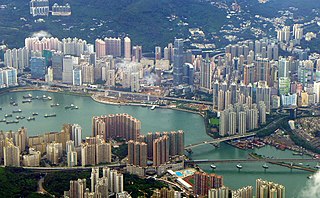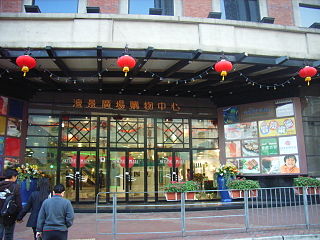
Tsing Yi, sometimes referred to as Tsing Yi Island, is an island in the urban area of Hong Kong, to the northwest of Hong Kong Island and south of Tsuen Wan. With an area of 10.69 km2 (4.13 sq mi), the island has been extended drastically by reclamation along almost all its natural shore and the annexation of Nga Ying Chau (牙鷹洲) and Chau Tsai. Three major bays or harbours, Tsing Yi Lagoon, Mun Tsai Tong and Tsing Yi Bay (青衣灣) in the northeast, have been completely reclaimed for new towns.

Tsuen Wan District is one of the 18 districts of Hong Kong. It is located in the New Territories and is served by the Tsuen Wan line of the MTR metro system. Its area is 60.7 km2. Its residents, who mostly live in Tsuen Wan Town, enjoy the highest income in the New Territories.
Hong Kong counts approximately 600 temples, shrines and monasteries. While Buddhism and Christianity are the most widely practiced religions, most religions are represented in the Special Administrative Region.

Tung Chung, meaning "eastern stream", is an area on the northwestern coast of Lantau Island, Hong Kong. One of the most recent new towns, it was formerly a rural fishing village beside Tung Chung Bay, and along the delta and lower courses of Tung Chung River and Ma Wan Chung in the north-western coast of Lantau Island. The area was once an important defence stronghold against pirates and foreign military during the Ming and the Qing dynasties.

Tai Wai is an area in the New Territories, Hong Kong, located between Sha Tin and the Lion Rock, within the Sha Tin District.

Sheung Shui is an area in the New Territories, Hong Kong. Sheung Shui Town, a part of this area, is part of the Fanling–Sheung Shui New Town in the North District of Hong Kong. Fanling Town is to its southeast.

Lei Yue Mun is a short channel in Hong Kong. It lies between Junk Bay and Victoria Harbour, separating Kowloon and Hong Kong Island. The channel is an important passage for the city, forming the eastern entrance of Victoria Harbour.

Sha Tin, also spelt Shatin, is a neighbourhood along Shing Mun River in the eastern New Territories, Hong Kong. Administratively, it is part of the Sha Tin District. Sha Tin is one of the neighbourhoods of the Sha Tin New Town project.

Ma Liu Shui is an area in Sha Tin District, in the New Territories, Hong Kong.

Tuen Mun or Castle Peak is an area near the mouth of Tuen Mun River and Castle Peak Bay in the New Territories, Hong Kong. It was one of the earliest settlements in what is now Hong Kong and can be dated to the Neolithic period. In the more recent past, it was home to many Tanka fishermen who gathered at Castle Peak Bay. Tuen Mun is now a modern, mainly residential area in the north-west New Territories. As of 2011, 487,546 live in Tuen Mun and over 95% of them are Chinese.

Tsing Lung Tau is a coastal residential area in the southwest coast of the New Territories in Hong Kong.

Chai Wan Kok is an area in Tsuen Wan, Hong Kong. It is located at the west end of Tsuen Wan Town. While its southeast is industrial area, its hilly northeast and coastal southwest are residential. It is on the main access between Tuen Mun and Tsuen Wan.
Articles related to Hong Kong include:

Tsuen Wan Pier, Tsuen Wan Ferry or Tsuen Wan Ferry Pier is a public pier at the south of Tsuen Wan, New Territories, Hong Kong, which is adjacent to the MTR Tsuen Wan West station. It provided ferry service to Central via Tsing Yi, but the service ceased operation in 2000 after Western Harbour Crossing and MTR Tung Chung line were commissioned to provide faster route between New Territories West and Hong Kong Island.

Skyline Plaza is a private housing estate and shopping mall in Tsuen Wan, Hong Kong. It is close to the Tsuen Wan Town Hall, Tsuen Wan Ferry Pier, Nina Tower and MTR Tsuen Wan West station. It was developed by the Henderson Land Development in April 1995.

Tai Wo Hau is a place in Tsuen Wan across Tsuen Wan District and Kwai Tsing District. Its area mainly includes Tai Wo Hau Estate, Kwai Yin Court, Kwai Yung Court, and private buildings along Texaco Road. It also includes Kwok Shui Road at the north of Castle Peak Road.
The following is a list of public housing estates in Tsuen Wan, Hong Kong, including Home Ownership Scheme (HOS), Private Sector Participation Scheme (PSPS), Sandwich Class Housing Scheme (SCHS), Flat-for-Sale Scheme (FFSS), and Tenants Purchase Scheme (TPS) estates.

Tsuen Wan Transport Complex was a large transport hub in Tsuen Wan, Hong Kong. There was a bus terminus and taxi stand on the ground floor; on top sat a multi-storey car park.























